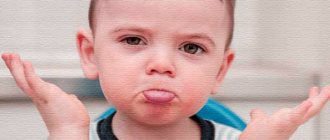Article:
All parents, without exception, wait for the moment when the child begins to say mom and dad.
Many people think that children's speech begins to develop on the day the baby pronounces the first word. In fact, for this to happen, we need long-term preparation of the articulation organs, their coordinated work, the ability to switch, mobility of the lower jaw, lips, tongue, and soft palate. It is impossible to pronounce exactly those sounds that make up the first words if the child does not know how to distinguish them from phonemes that sound similar, for example, words such as cat-whale, slide-crust and others. More precisely, human speech is formed during the prenatal period, when the organs of hearing, articulation and brain structures are formed. These processes are influenced by heredity, illnesses suffered by the mother, the presence or absence of bad habits, and the lifestyle of the baby’s parents. The course of labor and the state of health of the baby are important factors in his successful debut as a speaking and thinking person.
We will tell you at what age children begin to speak their first sounds, what this depends on, at what age children begin to speak in sentences, and how to help them go through each stage of speech development in a timely manner.
Speech in the first weeks and months of life
Immediately after birth, intensive development of brain structures begins, and new connections between neurons are established. At the same time, the organs of hearing and articulation develop, and physical and phonemic hearing is formed. Without proper hearing, children cannot master speech, since distortion or absence of sound signals entering the brain makes it impossible to develop speech skills.
In the first weeks and months of life, it is the speech of others that stimulates the initial stage of speech development. The baby listens to the speech of loved ones, he calms down for a while when he hears his mother’s voice, the impulsive movements of his arms and legs stop for a while. After some more time, he begins to turn his head towards the source of the sound.
Not all mothers and fathers talk to newborns and infants in the first months of life. They think this is unnecessary, because the baby doesn’t understand anything yet. Such one-sided “conversations” between parents and children, which accompany their bathing and waking, develop auditory concentration and the desire to respond. Attentive parents may notice how the child tries to move his lips, as if he wants to say something. It’s even better if parents often call the baby by name, show him toys, call the child, not moving much away from the crib.
This is the age at which a child begins to speak vowels and consonants. Up to 3 months, the child pronounces the following sounds:
- vowels – A, U, E;
- consonants – M, K, X, P, B, G.
These phonemes still sound unclear and are pronounced involuntarily. These skills mark the first stage of speech development – humming. In addition, the cry of a 1–3 month old baby is quite expressive. By intonation, the mother can determine whether the baby is bored, wants to eat, or it’s time to change wet diapers, that is, he has begun to master intonation.
From humming to babbling
At the beginning of the fourth month, the baby begins to look for an adult, smiles, and begins to intensively move his arms and legs (revitalization complex). He begins to emit drawn-out and melodious combinations of sounds - he cooes, saying a-a, a-gu, a-ha. Some sounds are simply impossible to reproduce; such phonemes do not exist in the Russian language.
After another 2–3 months, the turn of babbling comes. At first these are individual syllables pa, ka, na, ma, which a little later become similar to the peculiar words pa-pa-pa, ka-ka-ka, na-na-na. Most often, babbling appears when the baby is full, has slept and is in a good mood. This is not yet a speech, but preparation for it, a kind of preparatory exercise.
Although he does not speak yet, he understands a lot - he turns his head when he is shown a familiar toy, a bird, a cat. Children 6-7 months old fulfill simple requests - give a pen, play palms, and this is also a step towards speech development.
How to teach a child to speak before one year old
The development of speech in children under one year of age occurs in the complex development of the whole organism. A newborn has only a set of reflexes that gradually develop and turn him into a full-fledged personality. Speech is one of the important criteria for development. It is the result of coordinated activity of the brain, and the brain develops thanks to the activity of a child exploring the world in the first months of his life.
To speed things up, you can listen to the following tips:
- Talk constantly. From the first minutes, children absorb information about what they see and hear around them. Their hearing is already fully formed. You can talk about anything - what you dress him in, where you go, comment on any little things. Activities that accompany conversation promote faster understanding. After some time, the baby will be able to understand what they want from him.
- Repeat after your child. Usually children, even at such a tender age, try to say something. Often it resembles an endless repetition of one sound. This is how the baby trains diction. It would be great if his parents repeated after him. You can complicate the task by singing the familiar “zya-zya-zya” to the child. This way the baby will learn to keep the pace, which will also be useful for him in the further development of speech.
- Animal sounds. When your child communicates with animals, show what sounds these animals make. Is there a cat in the house? The child will quickly learn that she says “meow.” When the speech apparatus is sufficiently formed, the child will even be able to call the cat with the standard “kitty-kitty.” It’s even more interesting with dogs, as they are more friendly by nature. If there are no animals, you can reinforce the sounds with pictures;
- Train your baby's fine motor skills. Surely you have noticed that little children want to touch, grab, and crush everything? This is no accident. This is how the brain develops. By allowing your baby to play with cereals, sand, buttons and beads, you are doing him a good service, including accelerating the acquisition of speech. Naturally, all these exercises must be done under the supervision of parents, so that the inquisitive baby does not start eating sand or stuffing buttons into his nose.
- Organize communication with other children. Children can communicate with each other even more actively than with adults. They share their experiences, although often it looks like babble. If there are children in the company who already know how to speak, most likely the baby will imitate them. In addition, when playing with other children, the child gets pleasure, which is important for his development.
- Use sign language in doses.
It is easier for a child to show what he wants than to say. If this can even help right away (for example, when a baby points to a package of juice and the mother comments on what the juice is called), then in the future it is better to get the child to name the object.
Even with all this effort, you shouldn’t expect your baby to be quoting War and Peace by his first birthday. Usually the children with whom they work speak earlier, but in the same “gibberish.” Approach everything without fanaticism. Everyone has their own pace of development. The main thing is the health and well-being of the baby.
Constant training
Constant training is important for the development of the speech apparatus. That is why, during any interaction with a child, it is important to comment on what is happening. You can tell your baby about everything that is happening around. The more often the described actions are repeated, the faster the child will remember individual words, and then phrases. He most likely won’t be able to speak them yet, but he will understand.
For speech training to be successful, you need to follow some recommendations:
- Strike a balance between saying too much and too little. It is important to focus on one or two words.
- Highlight the names of objects and the actions that happen to them. Sentences should be short but meaningful.
- Talk about an object when the child has it in front of his eyes, or some action is performed with it.
- Read poems more often, but only emotionally and maintaining rhythm. The more emotionally you speak, the easier it is for the child to pay attention to the speech, and therefore to assimilate it.
- Use gesture games when talking and counting rhymes with clapping. Children after 6 months perceive them well.
- It is advisable to talk face to face. The baby follows the movement of his lips, remembering articulation and intonation.
- Ask questions. Even a simple question about whether you like the toy will do. The main thing is to wait for the reaction. It can be in any form - grumbling, smiling, even crying. If the baby enters into a dialogue, he needs to be motivated - praised, smiled, kissed.
You need to be in constant contact with your baby. Regular and systematic communication is the best way to speed up the development of his speech.
Expand your passive vocabulary
The child does not yet have an active vocabulary, because the baby simply does not know how to speak. But he can already recognize those things that he sees and uses every day. Of course, provided that parents use the tips described above.
A few more features of the passive dictionary extension:
- Regularly conduct “tours” of the house . If household items are familiar to you, then all this is new to your child. A regular TV remote can take several hours to use. Walk around the house with your baby, naming objects. For example, close and open the doors, turn the lights on and off, boil the kettle. These are everyday activities, but they will be very interesting for the baby, who will be able to learn many new words along the way.
- While walking on the street, show your little fellow traveler trees, benches, pine cones, a fountain, a house, and even an urn . The more objects he sees, the better.
- Name the parts of the body . The game will help the baby learn where his hands are, where his legs are, what kind of nose he has, etc. When the main elements of the face and body have been studied, you can tell what they are like - blue/green/brown eyes, long/short/straight/curly hair.
- Use games . For example, The world in the palm of your hand or We speak from the cradle. With the help of educational materials, your baby will speak much faster.
The expansion of passive vocabulary can be supplemented by looking at different pictures. The brighter and more interesting the pictures, the better.
Use simplified words
Babies cannot speak complex words. Their maximum is “ba ba ba,” that is, monosyllabic, frequently repeated constructions. If you want your child to learn to speak faster, it is better to name objects in the same simple words.
For example:
- dog - woof-woof;
- rain - drip-drip;
- goat - be-be;
- bell - ding-ding.
This simplification will not be excessive. For a child, simple words are the norm. Having learned them, the child will more actively develop speech. Their regular use will help prepare for more complex speech structures. Up to one and a half years, the introduction of simplified words is acceptable.
But it’s important not to overdo it here. Communicating with a child exclusively in simplified words will do more harm than good. It is better to use the full and simplified form of the word so that in the future the child can painlessly switch to standard speech. Retraining is too difficult a process.
https://youtube.com/watch?v=SFvwNmeqvIo
Roll calls
To teach a child roll calls, you need to know what sounds he already knows and likes to pronounce. Parents, as a rule, know all this, given that, having heard a new sound they like, the baby can repeat it for hours.
Knowing these syllables, say them in front of your child several times. Usually the baby reacts and begins to babble after the parent. If the child babbles on his own, repeat the new syllable after him. This way he will understand that you are reacting.
Then change the sounds and syllables yourself. The baby, having understood the essence of the game, will repeat sounds that are new to him. He may not succeed right away, but in any case, children really like such roll calls.
You can play roll call even if parents and children are in different rooms. The main thing is to pronounce the sounds loud enough. And there is no need to be distracted from everyday household chores. But there is advice - one lesson = one new syllable. At each roll call, syllables already learned can be repeated. And to maintain the child’s interest, it is worth using roll calls in poetic form.
For example, you've probably heard:
Geese, geese! Ga-ha-ha
Do you want to eat? Yes Yes Yes.
Development of fine motor skills of hands
Speech development in infants is influenced by games that involve fine motor skills. Scientists have long proven the relationship between fine motor skills and children’s ability to speak. The sooner the baby starts doing exercises to develop fine motor skills, the faster he will speak. The motor and speech centers of the brain are located nearby, and stimulation of one affects the functioning of the other.
Eastern practices say that there are points on the palms, the stimulation of which can affect the entire body. That is why you can do exercises with your baby’s fingers almost from birth.
But it is important to follow the following rules:
- You need to practice every day, devoting at least 2-3 minutes. More may not work, especially with very young children who sleep a lot and eat while they are not sleeping.
- It is better to choose the time to play while the baby is in a good mood;
- Be sure to praise the baby.
- The props used for games must be clean and safe. Kids may well taste an interesting little thing, and this should not cause allergic reactions or more serious problems.
- For the game it is better to use objects of different sizes and textures. They should differ in grip options so that kids learn to turn their hands in different directions.
You can massage your fingers, use a variety of rattles with a massage effect. Or buy toys that start singing or glowing after you press some buttons. If the toy also speaks, that’s great. But this accessory is suitable for children who are more than six months old.
How to stimulate babbling
From 6 months, children are able to move in space - sit and crawl. Their perception improves, they can repeat sounds after adults. This skill can be developed - as soon as the child pronounces the syllables, the parents repeat them after him. This technique develops hearing, articulation organs, speech exhalation, and encourages the baby to pronounce these syllables again and again. Such mini-lessons are carried out with a cheerful, well-fed and healthy baby. If he is cold, hungry, or unwell, verbal games with his parents will not do any good.
It’s good if the child sees the face of the one who is talking to him, then he will be able to repeat the movements of his mother or father’s lips. In order for sounds to be heard clearly, you need to ensure complete silence - turn off the music, mute the sound of the TV.
You can play “hide and seek” by covering the baby’s face with a diaper and saying “peek-a-boo.” Showing adults objects of the environment develops passive vocabulary well. In this case, you need to clearly name them, accompanied by a pointing gesture. Soon the child will find them with his eyes, reacting to the adult’s question “Where is the watch?”, “Where is the cat?”, “Where is the car?”
When do the first words and phrases appear?
It is impossible to name the exact date at which children begin to speak their first words. They can appear at 8–9 months and at 1 year 2 months. And all this is the norm. According to the observations of parents and teachers, girls usually start talking earlier than boys, although there are exceptions. At the turn between the first and second years, the baby’s vocabulary contains from 2 to 20 words. Usually this:
- simplified words (ma-ma, pa-pa, la-la, ki-sa, am-am);
- onomatopoeia (beep, peek-a-boo, peep-peep).
It is at this age that the child speaks to his mother. Why do children pronounce words in their native language? Because the adults around him single out from the baby’s babbling syllables and sound combinations that are inherent specifically in their language system, and repeat only them. Therefore, the period of babbling is important for the development of children's speech.
At one and a half years or a little later, the baby begins to combine words into sentences, as long as they consist of two words. The words in them are not consistent, an example of the following phrase: “Give me a doll” (give me a doll), “Papa is not there” (dad is not at home). But this is the age when attentive mothers notice that their baby begins to speak in sentences.
How to stimulate the pronunciation of words at 1 year old
By the age of 1, speech is not yet the most important means of communication for children. It is necessary to teach the baby to use speech. To do this, you do not need to immediately give the toy that the baby wants to take. First you need to say the name of the toy (you can simplify it): “Should I give you a la-la?” Let the baby try to repeat “la-la”, “beep-beep”. When presenting the desired item, you can emphasize: “This is lala, na.”
The vocabulary of an adult communicating with a baby should contain both full and abbreviated words: “kar-kar”, “ding-ding”, “knock-knock”, “tick-tock”. These substitutes for full words are temporary and are needed only because they are easier for the child to pronounce.
In order for children to establish a connection between a word and an action, you need to ask him to perform some action: give or take a toy, show a familiar object, wave a hand. Also verbalize all the actions that he performs with toys. For the same purpose, they play with 2–4 familiar toys and ask the baby, for example, to take a ball, throw it or catch it. Adults carry out all actions emotionally, clearly pronouncing both words-objects and words-actions.
Useful tips
How to teach a baby meaningful speech? The mother should communicate more with the baby, talk constantly. For the baby, the native language is still unusual: he learns it as a foreign language. Therefore, active communication with the baby will help you master speech faster. Without this, the baby’s speech development will occur very slowly.
All mothers want to hear such a cherished word “mama” from their baby. How can I teach him to say this word?
There are some pretty simple practical tips:
- Accompany all your actions with the word “mother”: mother speaks, mother wants to teach, mother begins to feed her son;
- play the game “Where is Mommy?” – cover your face with your hands and ask the baby;
- when you stroke the child on the head, say: mother strokes her son (daughter);
- when the baby says a word meaningfully, repeat it after him and kiss him on the cheeks;
- when you say a word to teach a child, look into his eyes;
- If you want to teach your baby to say a word, repeat it more often.
Important! Always emotionally praise your baby for any achievements. It is very important.
How many times do you need to say the word “ma-ma” for your baby to start saying it? As many times as you like until you learn. Remember that even for an awkwardly pronounced word you need to joyfully praise the baby. Encouraging praise is an incentive for further development.
Tips for active parents
The development of a baby’s speech directly depends on whether it develops spontaneously, or whether parents take direct part in its development. This determines at what age children begin to speak sounds/words/sentences. Positive conditions for the formation of children's speech:
- There is no need to force speech development with frequent exercises that are not appropriate for the baby’s age - there is a high risk of speech negativism, stuttering and nervous tics, since the capabilities of the child’s brain are not limitless.
- There is no need to lisp, faking your speech as a child’s speech, and often use diminutive suffixes - the only thing worse than this can be a complete disregard for communication.
- Delicately correct speech mistakes made by your child, never make him laugh, but show him an example of the correct pronunciation of a given speech utterance. For example, I see houses, yes, you see houses.
- Protect your baby from communicating with people with speech defects (burr, stutter), and especially with illiterate speaking adults (put down - lies, mouths - mouths, beautiful cat - beautiful cat), this “infects” and “invades” children’s speech so much that Such imitations are eradicated with great difficulty.
- When reading children's works, watching cartoons with your child, always explain unfamiliar words, the actions of the characters, and pay attention to vivid turns of speech.
It is very useful to record and listen to the baby’s speech every month - humming, babbling, first phrases, reading poetry. Such an archive will one day become an excellent gift for an older child and your grandchildren.
Today we answered the question of when should a child start speaking and at what months do the first sounds appear. If you suspect a delay in speech development in your baby, consult us. We will dispel anxiety, and if it is objective, we will tell you how to talk or simply teach your child to speak. We know more than a dozen examples of how parents sit and wait for their child to speak at 3, 4 and even 5 years old, although the development of big problems is already clearly visible. Ask us, we've been doing this all our lives!
The process of speech evolution
To correctly understand what a child begins to do and when, it is important to know the approximate phases of the baby’s speech development.
- Up to three months, the newborn makes individual sounds.
- At about four months of age, the baby begins to babble. This is a stream of incoherent sounds, in which sometimes even whole words can be distinguished. However, this is just an accident.
- Before nine months, children learn to form simple words and begin to learn the richness of intonations in adult speech. It is during this period that one can hear “mom”, “dad”, etc. for the first time. What the first word will be depends largely on the parents. Children tend to repeat what they hear most often.
- By the age of one and a half years, a child usually has several words in his arsenal, which he actively uses and understands their meaning.
- During the second year of life, children expand their vocabulary to two hundred words. They listen with interest to what and how adults talk. They remember every word and make simple sentences.
- The next year is very important in a child's life. He begins to realize himself as a person, learns to write complex sentences, begins not only to retell the books read to him, but even to invent his own stories. Many children are already going to kindergarten, where they begin to communicate with other children and adults and expand their horizons.
This is an approximate diagram reflecting when children usually begin to say “mom”, at what months they can be taught to communicate with other people. However, these averaged data cannot be used to control the development of the baby. As mentioned above, every child is unique. Some people already learn the first quatrains in a year, while others are still stubbornly silent at three.











